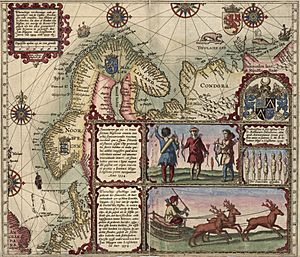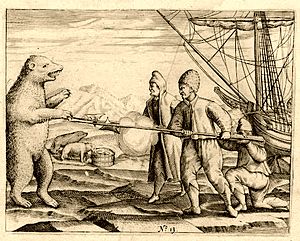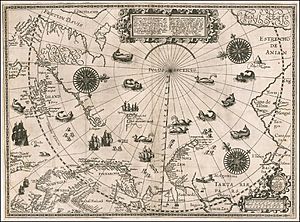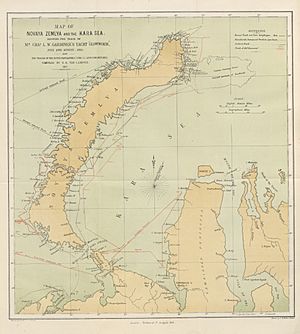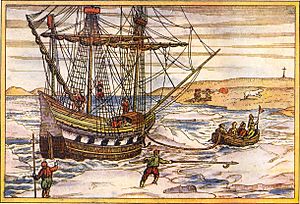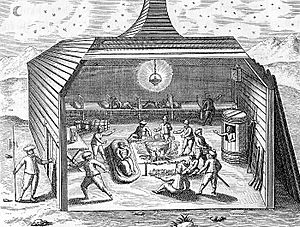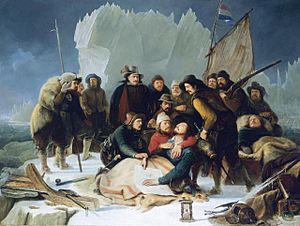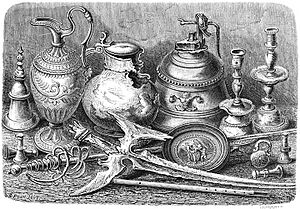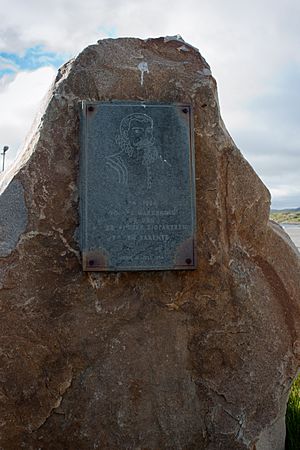Willem Barentsz facts for kids
Quick facts for kids
Willem Barentsz
|
|
|---|---|

Willem Barentsz
|
|
| Born | c. 1550 Formerum, Terschelling, Seventeen Provinces
|
| Died | 20 June 1597 (aged 46–47) at sea in the Arctic region
|
| Nationality | Dutch |
| Occupation | Navigator |
| Known for | Exploration of the Arctic |
Willem Barentsz (born around 1550 – died June 20, 1597) was a famous Dutch navigator, mapmaker, and Arctic explorer. His name is sometimes written as William Barents or Barentz in English.
Barentsz made three important trips to the far north. He was trying to find a new sea route, called the Northeast Passage. This route would allow ships to travel north of Europe and Asia to reach China. He explored places like Novaya Zemlya and the Kara Sea. On his third trip, his crew found Spitsbergen and Bear Island. But then, their ship got stuck in the ice near Novaya Zemlya, and they had to stay there for almost a year. Barentsz sadly died on the way home in 1597.
Many places are named after him, including the Barents Sea.
Contents
Life and career
Willem Barentsz was born around 1550 in a village called Formerum. This village is on an island named Terschelling in what is now the Netherlands. His name "Barentsz" wasn't a family name. It meant "Barent's son," showing who his father was.
Willem Barentsz was a mapmaker. He traveled to Spain and the Mediterranean Sea to create a detailed map book, also known as an atlas, of that area. He published this atlas with another person named Petrus Plancius.
His main goal as an explorer was to find the Northeast Passage. He believed there had to be clear, open water north of Siberia. He thought this because the sun shines all day long in the Arctic during summer, which should melt the ice. He even thought there would be less ice the further north you went.
First voyage
On June 5, 1594, Barentsz left the island of Texel. He was on a small ship called Mercury. This was part of a group of three ships. Each ship went in a different direction to try and find a way into the Kara Sea. They hoped this would lead them to the Northeast Passage. Barentsz stopped at Kildin Island for a few days.
On July 9, the crew saw a polar bear for the first time. They shot and wounded it when it tried to get on the ship. The sailors wanted to capture it and take it back to Holland. But once the bear was tied up on the ship, it became wild and had to be killed. This happened in a place they called Bear Creek.
When they found the Orange Islands, the crew saw about 200 walruses. They tried to hunt them with axes and spears. But it was much harder than they thought. Their tools broke against the walruses' tough skin. They only managed to get a few ivory tusks.
Barentsz reached the west coast of Novaya Zemlya. He sailed north along the coast. But then, huge icebergs forced him to turn back. Even though they didn't reach their final goal, this trip was seen as a success.
Jan Huyghen van Linschoten was also on this expedition and the next one.
Second voyage
The next year, Prince Maurice of Orange was very hopeful after hearing about Barentsz's first trip. He made Barentsz the main pilot and leader of a new expedition. This time, six ships joined, filled with goods to trade with China.
They set sail on June 2, 1595. The ships traveled between the Siberian coast and Vaygach Island. On August 30, they met about 20 "wild men" from the Samoyed group. They could talk to them because one crew member knew their language. On September 4, a small group went to States Island. They were looking for a type of crystal they had seen earlier. A polar bear attacked the group, and two sailors were killed.
In the end, the expedition had to turn back. The Kara Sea was frozen because of unexpected weather. This trip was mostly seen as a failure.
Third voyage
By 1596, people were disappointed that the earlier trips had failed. So, the government announced they would no longer give money to these voyages. Instead, they offered a big reward to anyone who successfully found the Northeast Passage. The city of Amsterdam bought and prepared two small ships. These ships were led by Jan Rijp and Jacob van Heemskerk. Barentsz was in charge of the whole mission. They left on May 10 or 15. On June 9, they discovered Bear Island.
They found Spitsbergen on June 17, seeing its northwest coast. On June 20, they saw the entrance to a large bay, later called Raudfjorden. They anchored there and put up a post with the Dutch coat of arms. On June 25, they entered Magdalenefjorden. They named it Tusk Bay because they found walrus tusks there. The next day, they sailed into Forlandsundet. But they had to turn back because the water was too shallow. So, they called it Keerwyck (meaning "inlet where one is forced to turn back"). On June 28, they sailed around the northern tip of Prins Karls Forland. They named it Vogelhoek (Bird Corner) because of all the birds they saw. They sailed south, passing Isfjorden and Bellsund. These places were marked on Barentsz's map.
The ships returned to Bear Island on July 1. This led to an argument between Barentsz and Van Heemskerk on one side, and Rijp on the other. They decided to go their separate ways. Barentsz continued northeast. Rijp headed straight north, hoping to cross over the North Pole to China. Barentsz reached Novaya Zemlya on July 17. He wanted to avoid getting trapped in the ice. He planned to go to the Vaigatch Strait. But his ship got stuck among many icebergs and floating ice.
The 16-man crew was stranded. They had to spend the winter on a bare cliff. They tried to melt the frozen ground, but it didn't work. So, they used driftwood and wood from their ship to build a lodge. It was about 7.8 by 5.5 meters. They called it Het Behouden Huys (The Saved House).
The crew faced extreme cold. They realized their socks would burn before their feet even felt warm from a fire. So, they started sleeping with warmed stones and cannonballs. They used the cloth from the ship to make more blankets and clothes. The ship had salted beef, butter, cheese, bread, barley, peas, beans, groats, flour, oil, vinegar, mustard, salt, beer, wine, brandy, hardtack, smoked bacon, ham, and fish. Much of the beer froze, bursting the barrels. By November 8, Gerrit de Veer, the ship's carpenter who kept a diary, reported they were running low on beer and bread. Wine was rationed four days later.
In January 1597, the crew saw and wrote about a strange sight in the sky. This event is now called the Novaya Zemlya effect, named after this sighting.
The group was somewhat successful at hunting. They caught Arctic foxes in simple traps. The raw meat of the Arctic fox has small amounts of vitamin C. The sailors didn't know this, but it helped them fight off scurvy, a disease caused by lack of vitamin C. Polar bears kept attacking the crew where they camped. The bears even used the stranded, empty ship as a home during the winter. Their simple guns often didn't kill the bears with the first or second shot. They were also hard to aim. The cold, brittle metal weapons often broke or bent.
By June, the ice still held the ship tightly. The remaining survivors, suffering from scurvy, took two open boats. Barentsz died at sea soon after, on June 20, 1597. We don't know if he was buried on the northern island of Novaya Zemlya or at sea. It took seven more weeks for the boats to reach the Kola Peninsula. There, they were rescued by a Dutch merchant ship. This ship was commanded by Jan Rijp, who had been on Barentsz's earlier trips. Rijp had returned to the Netherlands and was on a second voyage. He thought Barentsz's crew was lost and found them by accident. By that time, only 12 crewmen were left. They didn't reach Amsterdam until November 1. Some records say two men died on the ice and three in the boats. Others say three died on the ice and two in the boats. The young cabin boy had died during the winter in the shelter.
Excavation and findings
The wooden lodge where Barentsz's crew stayed was found untouched by a Norwegian seal hunter named Elling Carlsen in 1871. Carlsen drew a sketch of the lodge. He found two copper cooking pots, a barrel, a tool chest, a clock, a crowbar, a flute, clothes, two empty chests, a cooking tripod, and some pictures. Captain Gunderson landed there in 1875. He collected a grappling iron, two maps, and a handwritten translation of other explorers' journeys. The next year, Charles L.W. Gardiner also visited the site. He collected 112 more items. This included a message from Barentsz and Heemskerck for future visitors. All these items ended up in the Rijksmuseum Amsterdam.
An amateur archaeologist named Miloradovich found more items in 1933. These are now in the Arctic and Antarctic Museum in St. Petersburg. Dmitriy Kravchenko visited the site in 1977, 1979, and 1980. He sent divers into the sea, hoping to find the wreck of the large ship. He brought back several items, which went to a museum in Russia. Another small collection is at the Polar Museum in Tromsø, Norway.
In 1992, a group of scientists, a journalist, and photographers went back to the site. They put up a special marker where the cabin once stood.
The place where Barentsz's crew spent the winter on the ice has become a place for tourists. Icebreaker ships take visitors there from Murmansk.
Legacy
Two of Barentsz's crew members later wrote about their journeys. Jan Huyghen van Linschoten was with him on the first two trips. Gerrit de Veer was the ship's carpenter on the last two trips.
In 1853, a sea that used to be called the Murmean Sea was renamed the Barents Sea in his honor. Barentsburg, a town in Svalbard, Barentsøya (Barents Island), and the Barents Region were also named after Barentsz.
In the late 1800s, the Maritime Institute Willem Barentsz was opened on Terschelling. This is a school for sailors.
In 1878, the Netherlands named an Arctic exploration ship the Willem Barentsz.
In 1931, a play about Barentsz's third voyage was published, but it was never performed.
In 1946, a whaling ship was renamed the Willem Barentsz. In 1953, a second whaling ship with the same name was built.
A protein found in fruit flies was named Barentsz, to honor the explorer.
Dutch filmmaker Reinout Oerlemans released a movie called Nova Zembla in November 2011. It was the first Dutch 3D movie.
In 2011, a group of volunteers started building a copy of Barentsz's ship. They are building it in the Dutch town of Harlingen. The goal was to finish the ship by 2018.
See also
 In Spanish: Willem Barents para niños
In Spanish: Willem Barents para niños


